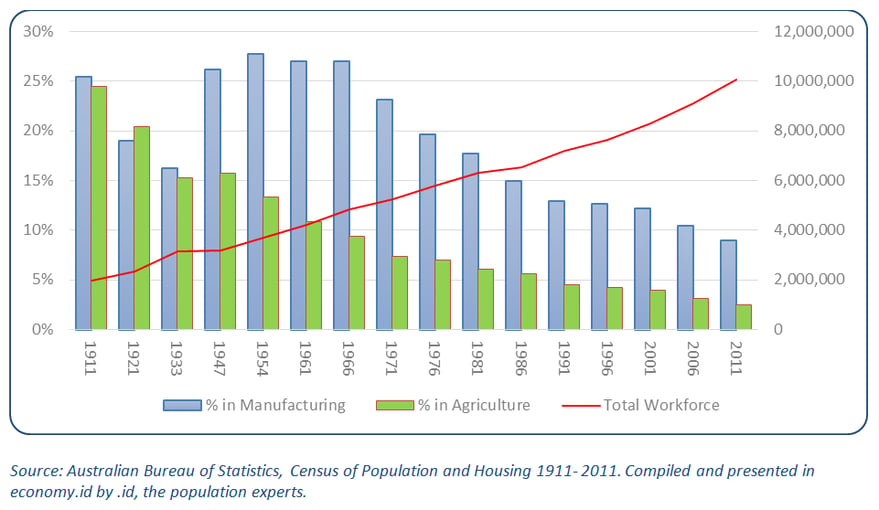GDP has grown steadily over decades, despite some economic shocks, and wages, employment and productivity have generally performed well. In the decade leading up to 2013 the size of the economy has grown at record levels, almost tripling, despite the GFC. How did this happen? What has allowed us to grow and prosper despite the old powerhouses losing their steam?
Gone are the days when the Australian economy was driven by agriculture and manufacturing. We no longer ‘ride the sheep’s back’, and factory jobs have not kept pace with population growth since the 1960s.
Comparing 2011 data with the census from one hundred years ago shows how much the economy has changed.
In 1911 the census revealed that around 52% of the national workforce was engaged in production or farming based industries. By the 2011, a century later, it was down to 11.5%.
Primary production (agriculture) which went from being a principal source of jobs down to 2.5% of the workforce and only 3% (1) of national economic output. Manufacturing accounted for 1 in 4 jobs throughout the 40s, 50s and 60s. Now it is less than 1 in 10. In fact, around only 130,000 jobs have been added to these two sectors at a time when the total workforce increased from 1.9million to over 10million people.

Unquestionably, these industries are no longer the economic dynamos they once were. Fortunately, as these industries have declined, the wealth of our country has maintained an ‘upwards trend‘. The reason is, of course, multifaceted, but one factor is a new driver of economic growth: human capital.
Human capital is the store of knowledge, skills, talents, experience, wisdom and intellectual attributes that we all contain in our heads.
It is unlike the tangible nuts and bolts, or plough and harrow, of the old economies. It is a non-physical asset that substitutes horsepower with brain power.
It plays an important economic role as a source of innovation and learning and provides access to better technology, process improvements and new efficiencies for legacy industries to learn how to do more with less.
Also, sectors that rely heavily on human capital, as a means of production, are the emerging sources of jobs and growth in domestic product. Health Care & Social Assistance, Education & Training, Professional, Scientific & Technical services, Finance & Insurance Services, and Information Media and Telecommunications, now account for 1 in 3 jobs. They also account for 32.7 % (1) of value added to the economy, and require much less resources than mining, construction or manufacturing in the process.
People are using their ideas and energy to drive economic growth.
However, the abstract nature of human capital can sometimes make it difficult to identify and measure. This is why we include workforce profiles in economy.id. In this section (see example here), the list of metrics can be used to define and monitor human capital.
Qualifications, area of expertise, age profiles, working hours, incomes, occupation, and employment can all be examined for each year since 2001 for all industries. These indicators show you the capabilities, or human capital, in each region and how it is changing over time.
Human capital is the new driver of economic growth. This puts workers in the driver’s seat. Businesses are now recognising that access to human capital is a primary consideration when making location decisions and they are using economy.id to identify opportunities.
But some things don’t change. Like all assets, whether they are physical like a factory or piece of farm equipment, or if they are non-physical, like skills, experience or knowledge, human capital must be invested in, maintained, and fostered in order to support economic growth.
(1) Source: National Institute of Economic and Industry Research (NIEIR) ©2014. Compiled and presented in economy.id by .id the population experts












